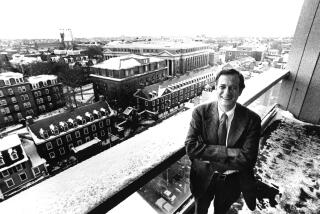The Author as Appurtenance : SIGNS OF THE TIMES: Deconstruction and the Fall of Paul de Man, <i> By David Lehman (Poseidon Press: $21.95; 318 pp.)</i>
- Share via
What am I, a present-day reader, to Aristotle?
Dumber.
Still. Aristotle is only around today because a certain number of present-day readers read and use him or, more exactly, because they read and use the work of writers who have read and used him, or--perhaps even more exactly--the work of writers who have read and used the work of writers who have read and used him.
So it is the reader who counts? In any case, it is the reader who has the power. And power is one of the threads discerned by David Lehman in his remarkably witty and readable book about post-structuralism, a method of reading and thinking that has spread like--you may choose--wildfire, poison ivy or cuisine minceur (because it came from France)--through the academic fields of literature, anthropology, history and several others.
Power is important in two senses. First of all, because post-structuralism or deconstruction gives new scholars all kinds of new things to do with classical texts, so picked over by generations of preceding scholars who interpreted and reinterpreted a “King Lear” or a Keats ode until perhaps it seemed dismaying to think of anything very dramatic to say about them. Such interpretation assumed that the author was mainly responsible for what was discovered, although unintended meanings or nuances also were looked for. In any case, there was meaning in the work however it got there; and it was there to be found.
Deconstruction more or less evicts author and inherent meaning from literature and history. That leaves a lot of room for its practitioners to move around in. Some of them write “Shakespeare” in quotes instead of Shakespeare, as if to think in terms of an author was an endearing fallacy. Of course, they say, there was such a figure, and no doubt he wrote (unless the Earl of Oxford did), but what in fact he wrote was not really a play, but only a text, and texts are simply raw materials for the reader to interpret. Or, if the reader is a deconstructionist scholar, to interpret and write about. “Lear” is not Shakespeare’s but ours. The interpretation is the creative part, and it is vastly free. The great authors and their works lie in textual vats, like stocks of chemicals. The critic/theorist/alchemist blends them into new and unsuspected potions and philters.
That is one kind of power. The author is demoted, the reader is enshrined. Not just any reader. The academic reader, with a Ph.D, a schedule of publication, and tenure.
The other kind of power is more prosaic. The Young Turk deconstructionists of the ‘60s are the department chairmen of the ‘90s. Networks are networks; even if “network” is a word whose meaning is not inherent but supplied by the user. Still, its reticulations are remarkably useful for toting home the groceries in.
Enjoying both kinds of power--the power to topple the traditional notions of literary merit and hierarchy, and the power to get and give jobs by so doing--it is natural that deconstruction continues to fuel one of the most indignant debates ever to hit the academic world.
David Lehman, a poet who is not an academic--he is a critic and wrote for Newsweek for a while--manages to explicate the convolutions of deconstruction virtually up to the point where it disappears, as some of its practitioners cheerfully admit, into the abyss of incomprehensibility. And he takes full and lively account of the storms it has raised. The tornado among these storms was the revelation four years ago that the late Paul de Man, a Yale professor who, along with Jacques Derrida, was deconstruction’s most revered exponent, had hidden his past as a Nazi collaborator in his native Belgium.
The deconstruction story and the de Man story divide Lehman’s book into two parts. Necessarily, there is some imbalance between the theoretical section and the factual reportage; yet Lehman has considerable success in linking them. He uses the de Man case as an exemplar of some of the blindnesses and dangers of what he calls “hard-core” deconstruction.
Lehman is relatively skeptical about it all, yet that “relatively” marks him close to unique. The subject conjures up mutually exclusive rages and some terrible prose. Lehman’s prose sparkles, and he writes with disarming good humor, underlying seriousness and as much clarity as the subject will stand.
Deconstruction, more or less, means dismantling. It dismantles many things, among them the notion that there is inherent magic, power, truth or grace in the word. Defining it is elusive, if only because deconstructionists are constantly deconstructing each other and themselves as well. Sawing off the limb you are sitting on, is how one of them puts it.
It sounds like fun, and originally, in France, it was a playful-serious way of turning meanings on their head and seeing what fell out of the pockets. In America, as often is true of French exports, the wit was industrialized. Frozen croissants, anyone?
There is no space here to give even the high points of Lehman’s tour of the deconstructionist world. An example may serve: The claim, by one writer, that the pin-prick causes the pin. Because: “If the effect is what causes the cause to become a cause, then the effect, not the cause, should be treated as origin.”
If there is a gist, it lies in one fundamental principle. Deconstruction breaks all connection between the word (signifier) and what it refers to (signified). Texts are about themselves, about , not by , their authors--that is, they reveal the author as the unconscious subject, not as the conscious creator--about whatever their reader uses them for. In this sense, Beowulf and Batman are equal.
It can be fun, as I say--if only the writing were not so ponderous--but only for a while. Because all constructions are different: Chartres, the Great Pyramid, the Parthenon. And all deconstructions--try telling the rubble apart--are the same.
Lehman goes thoroughly into the De Man affair. “In a profession full of fakeness he was real,” one of his disciples said when he died in 1985. It was a dubious notion for a deconstructionist. What is real?
Not de Man, it turned out in 1987, after a researcher researched too far. For two years during the war, he had written some 170 articles in the Nazi-controlled Le Soir newspaper in Brussels. Many of the articles praised the German revival as Europe’s cultural beacon; one, at least, was viciously anti-Semitic.
Emigrating to the United States after the war, leaving behind a shady publishing deal that bankrupted his father and enraged his creditors, De Man studied, taught and wrote. In his academic ascent he made no mention of his journalistic past, apart from a confidential exculpatory note to his academic superiors replying to an anonymous accusation. When he married one of his students, he also made no mention of having abandoned a wife, possibly common-law, and two children.
The revelations shocked his supporters. Some tried to justify him; most did not. On the other hand, they aroused undoubted glee in those who detested deconstruction and its believers. It was not just a man who was at stake; it was the central paradox of the theory itself.
How could you repudiate de Man’s deceptions without betraying your deconstructionist principles? Because if you believe words have no link with external reality, on what basis do you reject his anti-Semitic screed and its subsequent concealment? To put it another way: Isn’t there something dangerous and inhuman about a doctrine that disconnects words from reality? Would a deconstructionist allow his child to lie to him?
And, for those who knew the gifted and radiant mind of the Yale professor, how could you argue for redemption by time and long achievement? If sin is a meaningless concept, redemption must be, as well.
More to Read
Sign up for our Book Club newsletter
Get the latest news, events and more from the Los Angeles Times Book Club, and help us get L.A. reading and talking.
You may occasionally receive promotional content from the Los Angeles Times.







